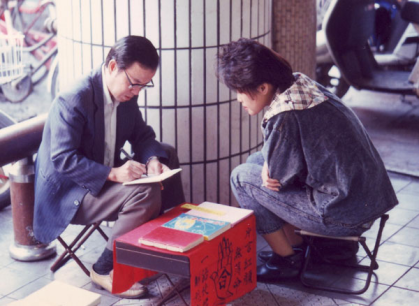 Use improv games to develop mindful presence–for groups and for you. Check out the new Playful Mindfulness book!
Use improv games to develop mindful presence–for groups and for you. Check out the new Playful Mindfulness book!

And for “a curious romp through the worlds of mindfulness and improvisation, subscribe to the Monster Baby podcast by clicking here!
The fall of 2014 marked the first Labor Day in twelve years that I hadn’t been gearing up to teach in a high school classroom, but that didn’t mean I wasn’t feeling the excitement of a new school year. New books, new students, new lessons—all possibilities remain in play every fall. In that spirit, I offer a fresh collection of improvisation exercises that can lighten spirits, develop courage, open spontaneity, and forge connection in classrooms of all sorts. The first installment of Spontaneity School has proven my most popular blog post. Here’s hoping this one resonates for as many readers!
1. Sound Ball (further variations)
In that original Spontaneity School post, I outlined a basic explanation for Sound Ball, one of the most fundamental and helpful improv games around. To review, with the larger group in a circle, one person ‘throws’ a random sound to another person in the group. That second person ‘receives’ the sound with the motion of catching a potato or small beanbag and—importantly—repeats as precisely as possible the sound sent to them. Right away, that receiver tosses a new sound with a new gesture to another person in the circle. The zippier the movement of sounds around the circle, the better. As always, encourage active physical gestures to send and receive and remind folks to resist planning ahead for ‘clever’ or ‘creative’ sounds. What comes, comes.
Try these added variations to enliven the game even further:
- Once you’ve gotten a few rounds of Sound Ball under your belt, have the group form pairs around the room. Each pair can then send their own sound ball back and forth in rapid-fire succession. To up the stakes, encourage a different physical gesture with each sound sent out. After a while in that mode, invite a new facial gesture with each sound. This variation gets good laughs, expands emotional and imaginative range, and builds the ability to pass the ball more quickly. Then, when you get the group back together, the game continues with far greater zip.
- See if participants can keep their attention focused on the sound ball as it moves around the circle, even if they’re not directly involved in the transfer. Move with the ball’s pattern as if you were surfing or serving its “energy.”
- Try a round of ‘Gesture Ball,’ where each person passes a random word illustrated by a hand or body movement. The gesture could demonstrate the word literally—like slapping hands together with the word ‘Clap!’—or it could offer the meaning more metaphorically, like throwing the hands out to the side with fingers flared and stepping forward with a bright smile to say ‘Jazz!’ In every case the person receiving the gesture ball should repeat the sound and the movement before sending a new combo along to the next person.
2. Ball
Whereas sound ball relies on an imaginary sphere, this game uses an actual, real-life ball (thus the name of the game!). The rules of Ball resemble those of volleyball—minus a court, a net, and any sense of opposing teams. In this case, the group works as one unit to keep the ball up in the air, counting aloud each time the ball gets hit. As in volleyball, no player can hit the ball twice in a row. If that happens or if the ball hits the floor, the count starts back at one.
Every so often, take time to harvest whatever insights the group can generate about what’s working to keep the ball alive. You’ll likely hear “Hit the ball up!” or “Be bold about moving into the center!” Try giving the cue to “Pass the ball to someone else rather than just hitting it!”—that will transform the quality of the game-playing.
For sure, the joy of a good round of Ball lasts far longer than the time you play. Tim Orr, a superlative improvisor and one of my favorite long-form teachers, suggests that an improv workshop that contained nothing but the game of Ball would still teach those attending most of what they need to know about the art.
Insider tips:
- Make sure to keep everyone counting aloud. It’s a great vocal warm-up that way and it builds a cohesion that’s valuable for whatever learning activity comes next.
- Switch people’s positions in the circle every now and then—new spot, new neighbors—to generate different permutations and possibilities.
- The ideal size for the ball is somewhere between a volleyball and a soccer ball. You want one that’s light enough not to damage your room or your players but sturdy enough to travel without much effort. A Gertie ball works well. Even better for the fully dedicated, find a fabric Boingo ball and pull its bladder out. Then, put a Gertie ball inside it, stitch the whole thing back up, and reinflate. The ball’s just the right weight—and you’ve got the pride of having made your own!
3. Three Things
This energy-builder works in any setting where you’ve got a few minutes between activities. The whole group forms a circle and chants in unison “Three things!” while bouncing their fists as if pounding a table. One leader then starts the game off by turning to an immediate neighbor and asking that person to name three things that fit a particular category. “Three brands of cars!” “Three things you’d find at the back of your closet!” or “Three terrible excuses for showing up late!” could all work. As quickly as possible, the receiver generates three responses and declares them with authority. When that person has finished, the group again chants “Three things!” and the person who just responded gives a category to the next person.
Maybe the answers will end up fitting the category “appropriately;” maybe they won’t. Or maybe the same answer will come out twice in one round. It’s all good. The crucial key: generate and celebrate the quick response. You’re trying to access a type of wisdom that comes before cognitive planning.
Insider tips:
- Some folks will lessen the tension of the challenge by adding in a little preamble before each response. Maybe they repeat the category or toss another time-staller in: “For military vehicles, I would choose a tank. I would choose a jeep. And I’d go with a Navy Destroyer.” Much better—and more rewarding to just say “Tank! Jeep! Destroyer!”
- Responders can build their own confidence by counting with authority on their fingers. Other players can help out by nodding or adding in small, affirmative sounds: “Mm-hmm; yes; right, of course,” though they don’t want to get so loud as to draw attention from the person on the spot.
- While you don’t want to get stuck on “accuracy”—it doesn’t really matter if a response fits the category—players should at least try to have the responses fit. Throwing out completely random words misses the point here.
- More abstract categories can stimulate a little more creativity—and a lot more laughs. “Three vegetables you’d find at the grocery store!” will work fine. “Three unpublished Harry Potter titles” might generate even more.
- Unlike most of the other spontaneity exercises where we’re trying to keep our minds fresh, this one’s actually a game where it can be OK to plan ahead in forming categories.
4. Jumpin’ Jehosephat
This playful but difficult game encourages dramatic commitment and generates good laughs by calling out the unexpected. Have two participants up at the front of the room sitting on chairs as if they were sitting on the porch of an old Country Store. One starts by slapping his or her knee and declaring “Well Jumpin’ Jehosephat and call me Christmas!” and then comes up with something surprising that character might have just learned: “Ole Mrs. Haverford’s getting ready to have another baby!”
The second character responds by slapping his or her own knee and coming up with another two-part exclamation of surprise: “Well, kiss my gizzard and grab me an onion!” The amazement then shoots back and forth , continuing the two-part expressions of shock without hesitation by diving into even more absurd declarations: “Well, take out the trash and kick what’s on the curb!” “Well, I’ve got Fridays and nobody’s watching!” Well, spread me some peanut butter and get me back to Georgia!” The game can go back and forth for a certain amount of time or could become a competition of sorts: first one to flinch leaves the porch and a new player comes on.
Insider tips:
- Encourage folks to start with the word “Well.” That way, they get a little momentum going into the declaration.
- The declarations don’t have to be completely non-sensical, just spontaneous and enthusiastic: “Well, tip the table over and call the dog to clean it!” still works even though it could be, um, logical.
- Alliteration can make for good laughs, as in “Well, sing along with Elvis and bring me back a biscuit!” Requiring such detail can make the game more challenging for those who master it quickly.
- As in sound ball, see if players can leave a pre-planned “good” idea and just take the next one that arrives when their turn comes along.
5. Shout the Wrong Name
This game builds the spontaneity muscle in an eat-your-spinach kind of way: it’s tough and can prove exhausting but builds a capacity for spontaneity in its purest form.
Start by having participants mill comfortably around whatever space they have. Then, for a first round, have them point to random objects around the room, shouting the name of whatever the thing is that they’re pointing to: “Desk! Doorknob! Trash can! Table lamp! Carpet! World map! Laptop!,” and so on.
Then, loosen them up with a second round where they say the name of the previous thing they’ve just pointed to. So if I were to start by pointing to the desk, I would then yell “Desk!” when pointing to the doorknob and “Trash can!” when pointing to the doorknob. See if they can get a good rhythm going there.
Lastly—and this represents the real challenge—have them point to objects and shout the name of anything else but that object’s real name. In this case, you could begin by pointing at the desk and yelling “Watermelon!” Or pointing to the doorknob and shouting “Cartwheel!” Offer a little demonstration and toss in a few abstract nouns as well, just to introduce the possibility of a wider vocabulary range. “Poverty!” when pointing at a coffee mug or “Alertness!” when pointing to a windbreaker on the wall.
Insider Tips:
- In the ideal, this game taps into a streaming flow of non-linear utterances. To that end, encourage speed. Use the physical movement of the point to propel the word out of the mouth. Better to shout a fast and declarative non-sensical sound than to wait several beats for a “good” word.
- Along those lines, try to limit any sense of judgment on words that come out, as in which are “better” or “worse.” Allow and observe repeats—always a good opportunity to see how the mind works! Odds are, any “Hey I’m doing well!” thought will snap folks right out of the flow anyway.
- Discourage participants from pointing at people, especially for the last round. You want to avoid the accident (or the intention) of something unpleasant or hurtful coming out—yelling “Idiot!” when pointing at a classmate, for example—even if it technically qualifies as “the wrong name.”
- Ask if anyone’s ‘strategizing’ to get themselves through. For example, I find this game much easier if I find my non-related words by moving through the alphabet: “Apple! Baseball! Carrot! Denver! Egg! Fahrenheit!” and so on. This can be a helpful aid for those who are struggling or a limiting crutch for those who could stand to push themselves further. Use such strategy as you see fit.
6. Convergence
Though this game starts with simple rules, it regularly provides rewarding payoffs. One person bring a word, any word, to mind and declares, “One!” Another person brings their own word to mind and announces, “Two!” Those two players then face each other, make eye contact, and count “One, two, three…” before simultaneously saying their word aloud. Maybe that first round generates “snowshoe” and “Mercedes Benz.”
Having heard those two words, all players then silently seek a third word that combines, bridges, or encompasses those two. (I find it helpful to imagine locating a word midway between the two, as if they were on a spectrum.) The first to come up with one possibility shouts “One!,” the next shouts “Two!” and those two use the same count-out-loud ritual to see if their words match. Probably they won’t—maybe you get “Germany” and “snowtire” in our example—and you keep going. Eventually, the group converges on the same word, usually to great delight, and one round is done. Almost inevitably, folks want to keep playing.
One tricky feature to keep in mind: once a word has been mentioned in a given game, you’re no longer eligible to use it.
Insider tips:
- Remember that you’re only trying to split the difference between the last two words mentioned, not making an ‘echo’ reference to something that came before.
- Players who have just offered words remain fully eligible to get in on the next round. Follow whoever’s got an immediate hit and good energy.
- It can be fun to watch how a given round weaves in and out of that feeling of convergence. The group can seem right on the edge of getting it and then drift back out to a wider gap before narrowing back down.
- Want a challenge? Include three people in each round and try to converge three words at a time.
7. Go! (Plus)
Here’s a great head-spinner to get folks moving and peripheral senses sharpening. Standing with the group in a circle, one person (A) starts by saying another person’s (B’s) name. Without moving, B responds to A, saying “Go.” A then slowly moves across the circle to fill in B’s spot. While A is moving B says another person’s (C’s) name. B stays in place until C gives ‘permission’ to move by saying “Go.” On that permission, B moves to C’s spot and the game continues in sequence. For the first round or two, it’s best to make sure everyone gets a chance to say “Go” and then move. You’re building up the game’s rhythm for the more challenging rounds to come. After a few rounds of “Go,” pause everyone and let them know you’re getting to the “Plus” stages of the game.
This time, create a pattern that moves from you to another person in the circle, from them to another, and then to another until it returns home to you. Initiate the sequence by choosing a category (“types of shoes,” for example) and then pointing to that first person on saying something that fits in that category (like “saddleshoes”). Unlike in Sound Ball, the recipient need not repeat what you sent, they only need to pass the pattern on to someone else, naming a different item in that category (like “pumps”). Eventually, the pattern returns home to you. Try that pattern a few times to make sure it’s well-established: each time sending the same item (shoe type, in our example) to the same person you sent to in the original go-round.
Then, clear those decks and establish another pattern with a different category (perhaps “international city,” or some such). Again, make sure everyone’s in the sequence and that the pattern comes back to you at the end. Once you feel confident folks have that pattern down, re-introduce the original pattern you created, executing both at the same time.
Lastly, when you’ve got both of those down, weave the “Go!” element back in. Now, you’ve got two patterns moving around the circle while people are also changing places and saying names and “Go!,” all at once. If the full-blown game sounds chaotic, that’s an appropriate read. When it works though, with kids and sounds breathing in and out of the circle, the game becomes a thing of beauty.
Insider tips:
- When establishing the patterns for the “Plus” part of the game, have those who have been included in the pattern put a hand on their head so those choosing where to go next who’s still available.
- Make sure that everyone establishes the patterns by sending to different people for each of the “Plus” rounds or it will get really confusing really quickly.
- If the group is strong, try introducing multiple versions of each pattern at the same time. You might have one “Go” going, two “shoes” patterns and two “international cities,” for example.
8. Three-Word-at-a-Time Poems
If you need a quiet experience to explore a given theme or want to help your learners understand the delights and challenges of shared control, this game may do the trick. Have folks arrange their desks or sit on the floor in a circle, each with a piece of paper and pen or pencil in front of them. Each person gets to start a poem, using only three words on the page. They should start with the title. If the title’s only one word long, they start the first two words of the poem. If the title’s incomplete after three words, they just write the first three words.
Then, once each person has written their three-word start, pass the poems to the next person, all poems moving in one direction. This second person then adds another three words before passing the poem again. Lines need not rhyme or contain any certain number of words—free verse usually works best. Depending on numbers, you can go around the circle however many times you need, though it provides a neat conclusion to have the same person who started the poem finish it.
Once the poems are complete, have each person read them aloud with great authority and distinction, as if they had written the whole thing themselves. If folks have played along sincerely throughout the exercise, you—and they—will likely be surprised with the quality and coherence of their work.
Insider tips:
- Encourage students to build on—“Yes, and”—what’s been written before them rather than trying to generate laughs by canceling another’s offer or going off in some random direction.
- Time the transfers so that everyone passes at the same time so you avoid getting multiple poems backed up at one spot and everyone’s got something to work on.
- It may help to give the ‘poets’ a heads-up that the end approaches before actually getting there: “Know that we’ll be ending the poems in just three more rounds so start to find a conclusion,” for example.
9. Shared Memory
This energizing game in pairs also comes from the shared-control/“Yes, And” family lineage. Divide your group into dyads and then set the stage for the following rules. Each pair needs to “reminisce” about an (imaginary) shared memory. “A vacation to Mexico” makes for a decent start, as would “The time we got lost in San Francisco.” Keep the topic light and somewhat breezy—you want your players to discovery joy in the shared memory.
One person starts by saying “You remember when we…” and continues on, making up some completely imaginary experience. At some point, the second person takes over, interrupting with an enthusiastic “Yeah, yeah, yeah…” or some such line, and then adding in another aspect to the ‘memory.’ Once each person has shared some part of the memory, send the lead back and forth so the memory keeps building.
In the ideal, the game gets going quickly with one player eager to jump in and add on what the other has offered. For variety’s sake, suggest that players experiment with pausing every now and then to leave some pregnant space between memories (as would often be the case with friends remembering a shared experience). Then, after soaking in the silence for a few seconds, they can listen for the next inspiration that comes and get the game moving again.
Insider tips:
- Keep a watchful eye for folks slipping into a blocking mode where they deny, dismiss, or belittle the ‘memory’ that the other person generates.
- Also make sure you don’t have two friends in a pair working on an actual The exercise is about discovering memories rather than actually recalling them.
- As is true for almost all improv exercises, “memories” in this game need not prove clever, funny, or original. Sometimes the most delightful shared memories are the ones that seem obvious.
- Offering a one-minute demonstration can help give folks an idea of what the game entails. It can also make for a fun little performance if you want to use it that way.
10. Diamond Dancing
This crowd-pleaser builds on groundwork laid in the game of Mirror (or Mirror Dancing), as described in the earlier Spontaneity School post. In this version, four players at a time take the stage to form a diamond shape with maybe 8 feet between each corner of the diamond. One person makes the front point of the diamond at the front of the stage, two stand at 45-degree angles behind that front person, and the last stands at 45-degree angles from behind those two, directly in line behind the front person.
Set up some lively, rhythmic music. Once it starts playing the student in front starts dancing in lead position—all other dancers follow the lead’s moves as closely as possible. After a good while in front, that dancer should turn to the right, bringing other dancers along and signaling that the dancer at the front of that direction of the diamond has now become the lead. Others follow that second person’s ‘choreography’ for a similar amount of time until he or she turns to pass the lead to the back point of the diamond. That third dancer directs the action before turning and passing to the fourth; the fourth assumes the lead before passing back to the front. Once all four have had their individual times to direct the diamond, dancers can lead and pass as they feel moved to. Whichever “DJ” runs the music can keep an active eye for when the piece looks finished and fade the music out before the next group cues up.
Insider tips:
- As with Mirror Dancing, lead dancers make it easier for their followers by moving more slowly. Or, as an alternative, by moving in quick-to-learn repetitive gestures. Dancers can also incorporate and reincorporate elements–movements, sequence, phrases—that other dancers first introduced. That helps make sense of the dance’s storyline, as it were.
- Dancers should look forward into the audience, trusting peripheral vision for new cues rather than looking directly toward each other.
- The dance gets tough if the transitions get sloppy. Encourage folks to be clear from head-to-toe when they’re turning that they’re handing over control. If the lead turns her hips in a new direction but leaves her shoulders facing the original way, how can the next player know what she means.
For a third group of games, make sure to check out Return of Spontaneity School!














[…] As with the rest of this post, I am copying this from the version listed here: […]